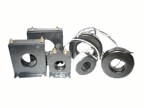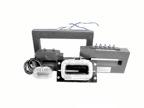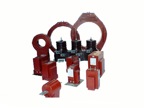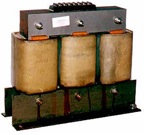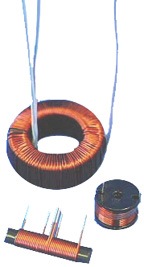|
|
|
Transformers and Inductors Experts

Auto Transformers
Control Transformers
Controlled Ferroresonant Audio Tranformers
Controlled Ferroresonant Ballasts
Current Transformers
Custom Coils
Edge Wound Transformers
Ferrite Core Transformers
Ferroresonant Transformers
Ferroresonant DC to ACs
Filament Transformers
Foil Wound Transformers
High Frequencys
Inductors (AC Line/Load, DC Link, DC Filter)
Medical Transformers
Mercury Vapor Ballasts
Potential Transformers
Power Transformers
Saturable Reactors Constant Voltage
Step-Up \ Step-Down Transformers
Toroidal Transformers (10 VA To 10,000 VA)
Vibratory Feeder Coils
| Auto Transformer |
Auto-transformers are used strictly in a step-up or step-down application. They are very similar to isolation transformers with one important exception. In an auto-transformer the primary and secondary windings are electrically common to each other. The advantage of using an auto-transformer over an isolation transformer is its smaller size, it’s lighter and cost less. The major disadvantage is that there is no isolation between the primary and secondary which allows noise on the power line to be directly coupled to the load. Another disadvantage is that auto-transformers provide no regulation. It is also important to note that the greater the change in voltage the less cost effective the auto-transformer is. Some common applications for auto transformers are motors, heaters, and other non sensitive loads. |

 |
| Control Transformer |
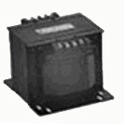 |
Control transformers are primarily used in a step-down environment to power low voltage circuits and / or accessories. Sizes: 5VA minimum rating.
|
| Controlled Ferroresonant (also see ferro's) |
This is special type of ferroresonant transformer that has an additional winding in which a variable DC control voltage is applied. When this winding is used in conjunction with a feed back circuit, the transformer provides much tighter secondary regulation. This can also be used to add flexibility to the output voltage based on the designer’s requirements, for example regulation adjustment for different frequencies. |
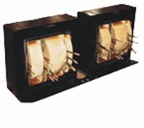 |
| Contolled Ferroresonant Ballast |

|
This ballast offers a linear variation of output power from 40 % to 100% as opposed to capacitor switching which changes lamp power as a step function. This is accomplished by varying the conduction time on an inductor which negates capacitance in the circuit allowing enhanced control of lamp current. Lamp current is sensed in a closed feedback loop circuit which can instantaneously respond to changes making the necessary adjustments. A PLC interface is available to communicate with the ballast in order to vary lamp output. In order to protect all of the control circuitry from power problems typically found on the primary, the control circuits are all located on the secondary of the ballast.
Features:
• Continuous variable output power from 40% power through 100% power
• Precise regulation. Less than a 2% change in output power over an input range of +l0% to -20%
• No need for mercury relays
• Very high input power factor. Typically better than 0.90
• High watt efficiency
• Controllable via a Programmable Logic Controller (PLC). A 4-2Oma signal is preferred with 0-5v and 0-lOv optional
• All components are pre-wired and tested at the factory
• Easy to wire. Just six wire connections need to be made to make the system operational
• Capable of running either standard mercury lamps or metal halide lamps
• Secondary wave-forms are designed to improve lamp life |
| Custom Coils |
 |
Control transformers are primarily used in a step-down environment to power low voltage circuits and / or accessories. Sizes: 5VA minimum rating. |
| Edge Wound Transformers and Coils |
Edge winding is a technique in which a rectangular magnet wire is wound on its narrow edge. This allows a much greater surface area to dissipate more heat than conventional winding techniques. Edge winding is used mainly in isolation transformers and inductors that have high load currents at lower voltages. |
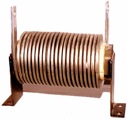 |
| Ferrite Core Transformers |
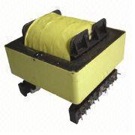
|
Ferrite materials are used for high frequency magnetic applications which include transformers and inductors. Ferrites are ceramic magnetic material comprised of ferric oxide and combinations of manganese, zinc or nickel. Ferrite materials are used because of their efficiency and responsiveness at these frequencies, enabling the power supply designer to reduce the size of magnetic designs dramatically. Cores come in over a dozen shapes and a multitude of sizes. The components in a power supply and the ferrite core transformer are closely intermingled electrically by design, and each has a great effect in the performance of the other. In this case it is important to fill out the general specification sheet and then for our engineers to work closely with you on these designs.
|
| Ferroresonant Transformers (Constant Voltage) |
A) FERRORESONANT SQUARE-WAVE TRANSFORMER
Used primarily in uninterruptible power supplies. The transformer is used to take a low voltage "pulsed square wave" generated by an inverter and battery, and convert it to an AC sine wave where voltage is regulated 1% to 5% depending on your requirement. Sizes: The typical size range for this product would be 100VA through 25KVA 50Hz or 60Hz. However, we can produce inverter transformers with any VA rating.
B) FERRORESONANT TRANSFORMER FOR DC OUTPUT
Used primarily in brute force DC power supplies. The ferroresonant transformer takes a sine wave input and creates a regulated square wave output, which is ideally suited for rectification. The square wave will produce a lower ripple than a sign wave using the same filter capacitor. Sizes: 25 watts to 10 kilowatts 50Hz, 60Hz, or 50/60Hz.
C) FERRORESONANT TRANSFORMER SINE WAVE
This takes a sine wave input and produces a sine wave output with a choice of output voltage variations of 1%, 3%, or 5 % for an input voltage variation of +10% to 20%. These are used in integrated power protection systems, protecting the critical load from all power problems with the exception of a blackout. Multiple voltages are available so this transformer can replace a multi-tap input transformer. Sizes: This product is available in sizes from 30VA through 75KVA single phase or three phase 50hz or 60hz.
|
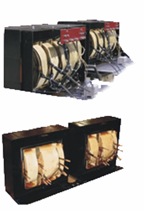
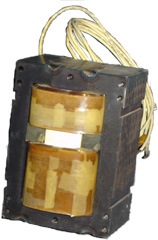
|
| Filament Transformer |
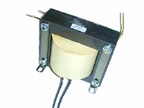 |
Similar to control transformers except they provide power to x-ray tube filament. Typically, one requirement is very high dielectric strength from the secondary to ground and from the primary to secondary. Sizes: over 50VA minimum rating. |
| Foil Wound Transformers |
Foil wound transformers used in high current applications. The coil is wound with either copper foil or aluminum foil. Used when low voltage high current is required. |
Additional benefits include improved temperature dissipation, reduction of hot spots, improved vibration capabilities, and reduced layer-to-layer voltage stress, yielding improved dielectric strength required for rugged applications. The reduced weight of the company’s foil wound transformers ensures that it is the ideal solution for restricted weight and volume challenges. |
| High Frequency |
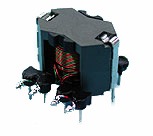
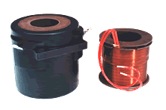
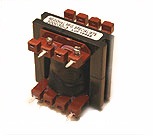 |
Custom transformers or inductors are wound on any bobbin or core. Typical cores included but are not limited to: EP's, ETD's, EE's, EC's, PQ's, RM's, UU's, drums, pots, rods and toroids. Common wire types: MW, Rubadue, Furukawa, Triple insulated, Nyleze, Polythermaleze, Litz, and Copper foil.
Typical operating parameters:
• Switching frequencies from < 20 KHz to >1 MHz
• Working voltages to >10 KV
• Inductances from < 1mH to > 1H
Typical applications:
• Custom Switch mode power transformers
• FET / IGBT Gate drive transformers
• Flyback
• Forward converter
• Push-pull and resonant topologies
• Drum Core Inductors
• Surface Mount Transformers
• Switch-Mode Current Sensors
• Common-Mode Toroidal Line Filters
• Differential-Mode Toroidal Line Filters
• Pulse Transformers and Inductors
• Air Core Coils
• Switching Regulator Output Inductors
|
| Medical Transformer |
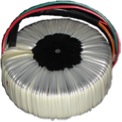 |
Used in medical equipment to protect the patient from electrical shock and potentially harmful leakage current. All transformers are double insulated and use a 5 mil copper safety shield to protect against a catastrophic failure on the primary or secondary side of the transformer in which case the current is shunted to ground. Also included are resetable thermal fuses. Standard leakage current is less than 100uA. Transformers bear the following marks: UL2601, UL544, CSA22.2 no 601.1, IEC2601, and TUV. |
| Mercury Vapor Ballasts |
Mercury vapor ballasts are designed to drive tubular medium pressure ultraviolet lamps. There are two types of mercury vapor lamps. The most common is the medium pressure lamp with no metal additives. This lamp is available in arc lengths of 1 to 120 inches. The other type of lamp is a metal-additive-mercury-vapor lamp. The additives used in the lamp create changes in the lamps spectral output enhancing different portions of the ultraviolet spectrum. The ballast initiates and controls the arc in mercury and metal additive curing lamp. This is accomplished by providing an instantaneous high voltage to strike the elements within a mercury vapor lamp, creating a plasma that, once initiated, is sustained by the ballast. Total wattages up to 50 kilowatts can be designed. Our constant wattage ballast consists of a transformer, capacitors and igniter.
The advantage of a constant-wattage ballast is that it allows for wide variations in input voltage to affect output wattage by only a few percent. These ranges can be customized to meet your applications requirements. Typical designs have an output variation of only +/- 3% with an input voltage varying over a range of -15% to +10%. Constant wattage is accomplished by a resonant tank circuit in which the lamp winding is in controlled magnetic saturation with the AC capacitors, such that voltage swings on the input side have a very small impact on lamp current. An interesting feature is that these current-limiting capacitors can be switched (see schematic) in and out of the circuit to provide various lamp power levels.
|
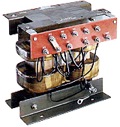 |
| Potential Transformers |
Used primarily in a step down environment to monitor voltage. They are designed for connection line-to-line or line-to-neutral in the same manner as ordinary voltmeters. The secondary voltage bears a fixed relation with the primary voltage so that any change in potential in the primary circuit will be accurately reflected in the meters or other devices connected across the secondary terminals.
Potential transformers can be used with voltmeters for voltage measurements or they can be used in combination with current transformers for watt-meter or watt-hour meter measurements. They are used also to operate protective relays and devices, and for many other applications, Since they are used in a monitoring capacity, they generally require much greater accuracy in design.
|
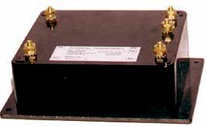 |
| Power Transformer |
Power transformers include insulating or isolating transformers. These terms are used to describe the "electrical isolation" of the primary and secondary windings, or insulation between the two. Often an electro-static copper shield is placed between windings to reduce electrical noise from primary to secondary. A grounded electro-static shield provides a safety factor preventing accidental contact between windings under faulty conditions.
Sizes: These are available in single phase or three phase up to 250KVA.
|
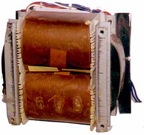
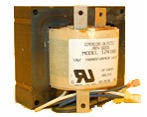 |
| Saturable Reactors |

|
Also known as Dial-A-Watt. Used primarily with mercury vapor ballasts to vary the output current (power) to the lamp.
This is done by introducing a DC current to the reactor. The reactor is connected across the capacitors on the ballast and "swings" current from the ballast. Primary current to the ballast remains constant regardless of power.
|
| Audio Transformer |
 |
These operate at frequencies between about 20 Hz to 20 kHz. Typical uses for audio amplifier circuits in older tube based designs to match the high impedance outputs of theses amplifiers to low impedance loudspeakers, |
| Step-Up \ Step-Down Transformers |
Used to either increase or decrease incoming voltage. Many are designed to do both (i.e. 120/208/240V in and 120/240V out) to handle worldwide voltages. Another very common application would he to step down voltage for DC rectification. Sizes: Single phase units from approximately 10VA to 100KVA and up to 250KVA for three phase units. Most voltages can be accommodated. Voltages are typically under 6KV for small units and 10KV for large units. |
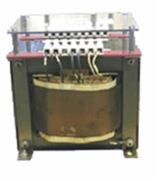 |
| Toroidal Transformers |
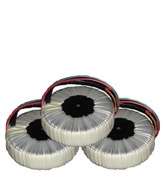
|
Toroidal transformers include power and auto-transformers, as well as inductors. Toroidal merely describes the geometric shape, similar to a donut. These transformers are typically more efficient because of the low core losses associated with a tape wound core, with no air gap. The shape also allows a larger portion of the copper windings to be exposed to the ambient air, enhancing cooling of the hotter copper windings versus the cooler iron core in a laminated transformer.
A toroid, when compared to a stacked laminated type transformer, would be about 50% lighter and 50% lower in volume simply because it is more efficient. Other advantages include low stray field, low mechanical hum, reduced no load losses, easy mounting and flexible dimensions.
|
| Vibratory Feeder Coils |
The vibratory inductor is a unique application for a simple choke design, for use in Vibratory Feeding Systems and Sorting Lines or Bowls.
Vibrations are set up, between an I-armature assembly and an IE-armature assembly, through the changing magnetic field of the core. The E-armature is usually secured to the solid equipment base, while the I-armature is secured to the bowl or line to be vibrated. The two armatures are positioned only a fraction of an inch from each other so that the E's and I's are coupled through the magnetic field. This gap can be variable to change the strength of vibrations. Coils can be provided potted or unpotted and are available with heavy weldments for solid attachment to the vibratory unit. Terminations are provided through flying leads, STO line cords, solder lugs, or quick connect lugs.
|
|
|
|
|
| |
Related Instrument transformers include: Instrument transformers, low voltage current transformers, medium voltage current transformers, low voltage ct, medium voltage ct, current transformer, potential transformers, low voltage potential transformers, low voltage pt, medium voltage potential transformers, medium voltage pt, pt, ct, current relay, voltage transformer, power transducers, Hall Effect, Hall-effect, DC, Direct Current, Magneto-Restrictive, Magneto restrictive, Hall Device, PCB current transformer, ANSI current transformer, Excitation curves, DIN-rail, Hall device, Ratio Accuracy, Power transducer, Frequecy Transducer, Voltage transducer, voltage transformer, current sensor, current sensing, current transducer, split core, split-core, toroid, toroidal, ground fault, ground-fault, phase reversal, phase loss, transmitter, energy, power, three-phase, three phase, 3 phase, indicator, relay, voltage, instrument transformer, electric, electricity, electrical, electronic
|
|












